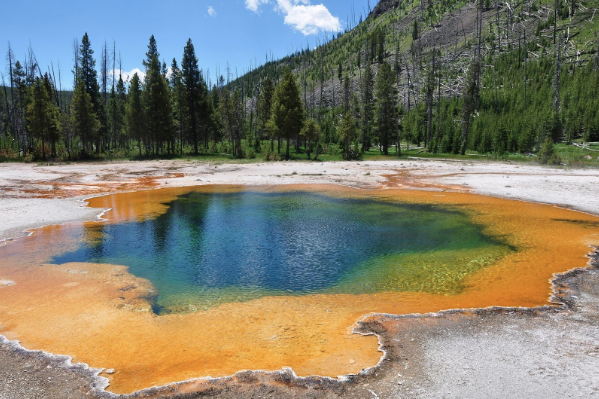Top Five Nature Reserves in the US
US nature reserves are scattered all over the country’s territory – from the East Coast to the West coast. Snowy mountain peaks and deep canyons, calm lakes and turbulent rivers, hot volcanoes and cold glaciers – each of them has something unique to offer to its visitors.
So don’t be confused when your professor gives you the task to write about one of these amazing places. Just ask yourself, “Who can write my custom essay?”
What follows below is a list of five beautiful nature reserves in the USA.
1. Yellowstone
- Yellowstone – a national park and biosphere reserve in the northwest region of the United States. Being under the protection of UNESCO, it is located in the territory of three states: Wyoming (the largest part), Idaho and Montana.
Covering an area of 8,991 km², the park is located at the very bottom of a huge valley which is surrounded on all sides by mountain peaks. In case you didn’t know, it takes its name from the identically named river running through the area.
- Location. Yellowstone Park occupies an area of 102 km2 from north to south and 87 km2 from east to west. The asphalt road (the so-called “Big Loop”) winding its way through it is 230 km long. The park is located some 80 km from Cody Airport (Cody, WY) and is reachable by buses running from Salt Lake City and Bozeman (the service operates from July to September).
- Infrastructure. The park has nine hotels (with more than two thousand rooms), shops, gas stations and a lot of campsites. It’s almost impossible to book a room there during the summer season, which is why many tourists prefer to stop over in towns located outside the park.
Yellowstone has 9 information centers and museums. Its most popular attractions include three thousand geysers, of which the most popular ones are called Steamboat and Old Faithful Geyser.
- Nature. There’s also the largest volcano in Yellowstone (aka a supervolcano). Called the Yellowstone Caldera, it looks like a huge hollow basin in the ground. More than 640 thousand years ago, there was a powerful earthquake here which resulted in the formation of a gigantic area covering 3825 km².
Here, you can find grizzly bears (as of 2016, there were a total of 690 of them here), gray wolves, white-tailed deer, bison, elks, mountain goats, coyotes, marmots. The park’s bird population includes white-headed eagles, American cranes, trumpet swans, and white pelicans.
2. Yosemite
- Located in the Sierra Nevada Mountains, California, Yosemite National Park is one of the most beautiful nature reserves in the United States. Since 1984, the park has been under the protection of UNESCO. Yosemite Park covers an area of 3026 km², and in its vast territory you can find some impressive granite rocks, picturesque valleys, beautiful meadows, stunning lakes and rivers with crystal clear water, magnificent waterfalls, and giant redwoods. It also has a large variety of animals and birds.
- Wild Life. About 5 million people attend the national park annually, 90% of whom go there solely for the purpose of visiting the Yosemite Valley. Located in the central part of the park, it has the picturesque Merced River running through it. It is also known for its picturesque locations, such as one kilometer-high El Capitan mountain, beautiful lakes, and waterfalls. The local forests have some diverse animal and plant life.
The Giant Sequoia growing here is the largest, tallest and most long-lived trees in the world. Yosemite is also famous for its numerous waterfalls which include Yosemite (739 m), Wapama (520 m), Snow Creek (652 m) and Briddlevale Falls (190 m).
- Infrastructure and Attractions. The park has some 1,300 km of walking trails and 560 km of roads. Here, you can go climbing, fishing, rafting, horseback riding and biking, skiing and snowshoeing. Yosemite also has some lodges, shops, and restaurants.
3. The Grand Canyon
- Located in Arizona, the Grand Canyon is one of the oldest national parks in the United States. Until the first Europeans arrived therein 1540, it was inhabited by the Pueblo Indians who lived there in caves hollowed out in the rock. The canyon owes much of its popularity to President Theodore Roosevelt who loved to come here to hunt. It is thanks to him that the place became a very popular tourist destination.
- History. With a length of 500 km, width of 28 km, and depth of 1.6 km, it is indeed the largest canyon on the planet. Though it may not be the deepest in the world, it can still boast of some very impressive landscapes.
18 million years ago, the waters of the surrounding rivers began to flow into the Colorado Plateau, a huge cleft which rose 3 km high. Over time, the soft stones it was made up of were gradually washed out, and today the canyon (especially it’s bottom) is formed by hard rock which will take one million years to fully wear out.
- Wildlife and Climate. The park’s flora and fauna are quite diverse due to its climate. The temperatures there range from +40 at the bottom to +15 degrees on top of the plateau. Its arid deserts with agaves, cacti, and yuccas are interspersed with lush forests full of oaks, birches, and pine trees.
It is home to more than 1600 plants, 90 species of mammals, 47 species of reptiles, 355 species of birds, as well as 26 species of fish and amphibians.
- Infrastructure. The northern area of the nature reserve is hardly suitable for tourism. There are many hard-to-reach paths here, and in winter this part of the park is completely closed to the public. However, those who dare to venture there will not be disappointed: this section of the park has some diverse flora and fauna, stunning landscapes, and a very special climate.
There are several ways in which you can explore the canyon: on foot (there are many convenient hiking trails); float down the Colorado River on rafts; on horseback; by train (there’s a railroad running along the edged of the canyon), bicycle or car.
4. Napa Valley
- Located in Northern California, Napa Valley is the main wine-making region of the United States which is famous all over the world for its grape-growing industry.
- Wine. Occupying an area of 14 thousand hectares, Napa Valley has a lot of vineyards, as well as four hundred large and small wine-producing farms. Wines made here are popular not only in America but also abroad – bottles with Napa labels can be found almost everywhere in the world. You can see how grapes are grown and wine is produced during a tour of Napa Valley. There are a lot of restaurants, gastronomy schools and a whole bunch of spas here.
- How to get there? The main cities of the Napa Valley are Napa, Yountville, Oakville, Rutherford, Saint Helena, and Calistoga. You can get there from San Francisco, Oakland, San Jose, and Sacramento. If you travel from San Francisco, you should take Highway 37 and cross the Golden Gate Bridge. All in all, it will take you about an hour and a half to get there.
5. Death Valley
- Death Valley – is the largest park in the Mojave Desert and the hottest place on Earth. With an area of 13,628 square meters. km, it has been around for about 500 million years. Death Valley got its name in 1849, during the California Gold Rush. In an attempt to quickly get to the gold mines, some of the gold prospectors decided to take a short cut through the desert. One person from the group never made it to their destination, while the rest were totally starved and dehydrated.
In fact, the place truly lives up to its name. This is one of the most lifeless and unforgiving deserts on the planet. The maximum temperatures in summer here can reach up to 46 °C, while in winter they can drop to zero.
- Route. All roads leading to the Death Valley offer some splendid views. For example, the scenery along US-95 (Nevada) or I-15 (California) is very similar to Argentine’s Patagonia or even Mongolia. However, if you take Hwy 190 through the Panamint Springs, you’ll get to enjoy a breathtaking panorama of the Sierra Nevada.
Any type of fuel is very expensive in the park, so it is a good idea to get a full tank in advance. Keep in mind that there is an information office in Furnish Creek, which is about 110 miles (2.5–3 hours) from Baker and 145 miles (3–3.5 hours) from Las Vegas.








